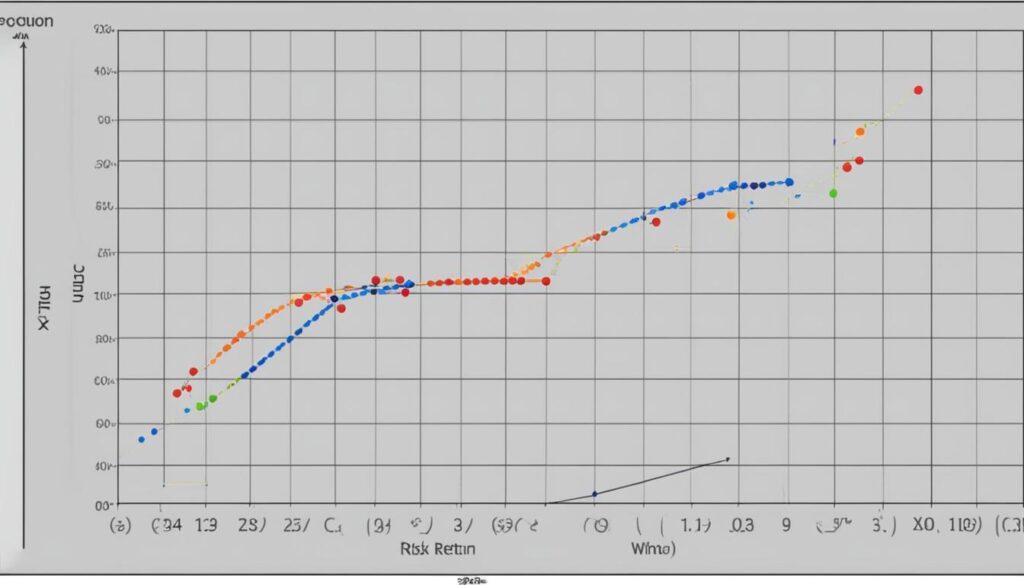Risk taking is fundamental to sound investing. Without risk, there could be no return. The concept of risk-return tradeoff forms the basis of portfolio theory. Successful entrepreneurs know how to manage risk and make calculated risk-taking decisions. Understanding your risk tolerance is crucial for effective risk management in investment.
Key Takeaways:
- Managing risk is essential for successful investing.
- Risk tolerance is influenced by factors such as financial goals and comfort with risk.
- Diversification and asset allocation are key components of risk management.
- Calculating risk involves assessing potential outcomes and weighing them against potential losses.
- Understanding your risk tolerance helps in constructing an investment portfolio that aligns with your goals.
The Importance of Risk Tolerance in Investment
Risk tolerance is a crucial factor in successful investment management. It refers to an individual’s ability to handle the fluctuations and uncertainties that come with investing. Understanding your risk tolerance is essential for constructing an investment portfolio that aligns with your goals and helps you navigate market volatility.
There are several factors that influence your risk tolerance. Financial goals play a significant role in determining the level of risk you are willing to take. If you have long-term goals and can tolerate short-term market fluctuations, you may have a higher risk tolerance. On the other hand, if you have short-term goals or prefer stability, your risk tolerance may be lower.
Time horizon is another crucial factor. If you have a longer time horizon, you may be able to tolerate more risk as you have more time to recover from market downturns. Conversely, if your time horizon is shorter, you may need to adopt a more conservative approach to minimize potential losses.
“Understanding your risk tolerance is like knowing yourself as an investor. It helps you make informed decisions and find the right balance between risk and reward.”
Asset allocation and risk analysis are key components in managing risk tolerance effectively. By diversifying your investments across different asset classes, you can spread out the risk and potentially minimize losses. It is important to periodically review your risk tolerance and make adjustments to your portfolio to ensure it remains aligned with your financial goals and risk preferences.
The Importance of Risk Tolerance in Investment
Risk tolerance is a crucial factor in successful investment management. It refers to an individual’s ability to handle the fluctuations and uncertainties that come with investing. Understanding your risk tolerance is essential for constructing an investment portfolio that aligns with your goals and helps you navigate market volatility.
There are several factors that influence your risk tolerance. Financial goals play a significant role in determining the level of risk you are willing to take. If you have long-term goals and can tolerate short-term market fluctuations, you may have a higher risk tolerance. On the other hand, if you have short-term goals or prefer stability, your risk tolerance may be lower.
Time horizon is another crucial factor. If you have a longer time horizon, you may be able to tolerate more risk as you have more time to recover from market downturns. Conversely, if your time horizon is shorter, you may need to adopt a more conservative approach to minimize potential losses.
“Understanding your risk tolerance is like knowing yourself as an investor. It helps you make informed decisions and find the right balance between risk and reward.”
Asset allocation and risk analysis are key components in managing risk tolerance effectively. By diversifying your investments across different asset classes, you can spread out the risk and potentially minimize losses. It is important to periodically review your risk tolerance and make adjustments to your portfolio to ensure it remains aligned with your financial goals and risk preferences.
| Factors Influencing Risk Tolerance | Explanation |
|---|---|
| Financial Goals | Determines the level of risk needed to achieve desired returns |
| Time Horizon | Length of time an individual plans to hold investments |
| Investment Knowledge | Understanding of investment concepts and strategies |
| Emotional Resilience | Ability to navigate market volatility and make rational decisions |
The Risk-Return Tradeoff and Portfolio Theory
The risk-return tradeoff is a fundamental concept in investment that states as the potential reward of an investment increases, so does the level of risk associated with it. This principle forms the basis of portfolio theory, which suggests that by diversifying investments across different asset classes, investors can optimize returns while minimizing risk. The pioneering work of Nobel Prize winner Harry Markowitz in portfolio theory highlights the importance of considering risk and return together when making investment decisions.
Portfolio theory emphasizes the need for investors to balance their risk tolerance with their desired level of return. By diversifying across various asset classes like stocks, bonds, and real estate, investors can create a portfolio that achieves the optimal tradeoff between risk and return. This approach helps to spread risks and mitigate the impact of potential losses in any single investment.
“Diversification is the only free lunch in finance.” – Harry Markowitz
Diversification allows investors to reduce exposure to market volatility and increase the potential for higher overall returns. By investing in different assets that have varying levels of correlation, they can effectively reduce the risk associated with individual investments. For example, if one asset class experiences a downturn, another asset class may perform well, offsetting the losses.
| Asset Class | Risk Level | Expected Return |
|---|---|---|
| Stocks | High | 8% |
| Bonds | Medium | 4% |
| Real Estate | Low | 6% |
This table showcases the risk level and expected return of different asset classes. By allocating investments across these asset classes according to risk tolerance, investors can create a diversified portfolio that maximizes returns while managing risk.
The Role of Asset Allocation
Asset allocation plays a crucial role in managing risk in an investment portfolio. It involves dividing investment capital among different asset classes based on an individual’s risk tolerance and investment goals. By determining the appropriate allocation, investors can balance the potential for return with the level of risk they are willing to undertake.
Effective asset allocation involves regularly reviewing and rebalancing the portfolio to ensure it remains aligned with the investor’s risk tolerance and market conditions. This approach allows investors to adapt to changing market dynamics and optimize their portfolio’s performance.
In summary, the risk-return tradeoff is a vital concept in portfolio theory, emphasizing the need for investors to balance risk and return when constructing their investment portfolios. Diversification and asset allocation are key strategies in managing risk and optimizing returns. By understanding the risk-return tradeoff and applying these principles, investors can make informed investment decisions that align with their risk tolerance and financial goals.

Calculating Risk and Making Informed Decisions
When it comes to investment, calculating risk is a crucial step in making informed decisions. Understanding the likelihood of achieving desired outcomes and weighing them against potential losses allows entrepreneurs and investors to evaluate their options effectively. However, risk calculation goes beyond simple probability analysis. It involves considering various factors, such as incomplete information and uncertainty, which can significantly impact the level of risk involved.
By carefully assessing these factors, individuals can gain a clearer understanding of the risks they face and make more educated investment choices. This involves setting realistic goals and analyzing potential rewards and drawbacks. Through rigorous risk analysis, entrepreneurs and investors can identify potential pitfalls and mitigate them by diversifying their portfolios or exploring alternative investment strategies.
One effective way to calculate risk is by conducting thorough research and analysis. By gathering and analyzing relevant data, individuals can gain insights into market trends, economic indicators, and industry-specific factors that may influence their investment decisions. This information empowers entrepreneurs and investors to make informed choices and develop strategies that align with their risk tolerance and goals.
Ultimately, calculating risk and making informed decisions requires a combination of data-driven analysis and subjective judgment. By understanding the intricacies of risk calculation, individuals can navigate the investment landscape with confidence, maximizing the potential for success while mitigating potential losses.

Table: Factors Influencing Risk Calculation
| Factors | Description |
|---|---|
| Financial Goals | The desired outcomes individuals aim to achieve through their investments, such as capital appreciation, income generation, or wealth preservation. |
| Time Horizon | The length of time individuals plan to hold their investments, which affects their ability to withstand short-term market fluctuations and pursue long-term growth. |
| Investment Knowledge | The level of understanding individuals have about different investment vehicles, financial markets, and industry-specific factors that may impact their investments. |
| Emotional Resilience | An individual’s ability to manage emotions, such as fear and greed, that may influence their investment decisions and ability to tolerate market volatility. |
The Power of Diversification
Diversifying investments across different asset classes is a proven strategy for managing risk and maximizing returns. By spreading investments across a range of assets with varying levels of correlation, investors can reduce the impact of market volatility on their portfolio. Diversification not only helps manage risk but also increases the potential for higher overall returns.
Nobel Prize-winning economist Harry Markowitz described diversification as the only free lunch in finance. It allows investors to capture the benefits of different asset classes while minimizing the downside risk associated with any single investment. By including a mix of stocks, bonds, real estate, and other assets in a portfolio, investors can potentially achieve a smoother and more consistent performance.
To illustrate the power of diversification, let’s consider a hypothetical example. Table 1 below shows the annual returns of two portfolios over a five-year period. Portfolio A is concentrated in a single asset class, while Portfolio B is diversified across multiple asset classes.
| Year | Portfolio A Return | Portfolio B Return |
|---|---|---|
| Year 1 | 10% | 8% |
| Year 2 | 5% | 10% |
| Year 3 | -2% | 6% |
| Year 4 | 8% | 4% |
| Year 5 | 12% | 7% |
As we can see from Table 1, while both portfolios had an average annual return of 6%, Portfolio B’s performance was less volatile compared to Portfolio A. This is because the diversification in Portfolio B helps to offset the losses in certain asset classes with gains in others, resulting in a more stable overall return. By spreading the risk across different investments, Portfolio B was able to achieve a more consistent performance over time.
In conclusion, diversification is a powerful tool for managing risk and optimizing investment returns. By diversifying across different asset classes, investors can potentially reduce their exposure to market volatility and increase their chances of achieving their financial goals. It is important to regularly review and rebalance your portfolio to ensure that it remains aligned with your risk tolerance and investment objectives.
The Role of Asset Allocation in Risk Management
Asset allocation plays a crucial role in effectively managing risk in investments. By strategically dividing investment capital among different asset classes, individuals can balance risk and return to optimize their portfolio’s performance. Asset allocation takes into consideration an individual’s risk tolerance and investment goals, and it helps minimize the impact of market fluctuations on the portfolio’s overall value.
Through diversification across asset classes such as stocks, bonds, and real estate, investors can reduce their exposure to any single investment and spread their risk. This diversification strategy helps mitigate the impact of market volatility and can improve the potential for long-term growth.
Table: Asset Allocation Strategies
| Asset Class | Allocation Percentage |
|---|---|
| Stocks | 60% |
| Bonds | 30% |
| Real Estate | 10% |
Asset allocation is not a one-time decision, but rather an ongoing process that requires regular review and adjustment. As an individual’s risk tolerance and financial goals may change over time, it is important to adapt the asset allocation strategy accordingly. Monitoring and rebalancing the portfolio can help ensure that it remains aligned with the individual’s investment objectives.
Understanding the Factors that Impact Risk Tolerance
Risk tolerance in investment is influenced by several factors that shape an individual’s ability to handle market volatility and make calculated decisions. These factors include financial goals, time horizon, investment knowledge, and emotional resilience. Understanding how these elements impact risk tolerance is crucial for effective risk management and achieving long-term investment success.
Financial Goals
One of the key drivers of risk tolerance is an individual’s financial goals. Different goals require different levels of risk to achieve desired returns. For example, someone with a short-term goal, such as saving for a down payment on a house within the next year, may have a lower risk tolerance and prefer more conservative investments. On the other hand, someone with a long-term goal, like retirement planning, may be willing to take on higher risks in pursuit of higher potential returns.
Time Horizon
The time horizon, or the length of time an individual plans to hold investments, also plays a significant role in determining risk tolerance. Generally, those with a longer time horizon have a greater capacity to weather short-term market fluctuations and can afford to take on higher risks. This is because they have more time to recover from any potential losses and benefit from the compounding effect of long-term investments. In contrast, individuals with a shorter time horizon may have a lower risk tolerance as they have less time to recoup any losses before needing to access their funds.
Investment Knowledge and Emotional Resilience
Investment knowledge and emotional resilience are two additional factors that can impact risk tolerance. Those with a deeper understanding of investment concepts and strategies may feel more comfortable taking on higher risks, as they are better equipped to analyze potential rewards and drawbacks. Emotional resilience, or the ability to remain calm and rational during times of market volatility, also influences risk tolerance. Investors who are more emotionally resilient may be able to tolerate a higher level of risk without making impulsive decisions based on short-term market fluctuations.

Conclusion
Understanding your risk tolerance is crucial for effective risk management in investment. By gauging your investment comfort zone and making informed decisions based on calculated risk-taking, you can optimize your portfolio’s performance and achieve your financial goals.
It is important to remember that risk is inherent in investing, and without risk, there could be no return. However, by understanding your risk tolerance, you can construct an investment portfolio that aligns with your goals and helps you navigate market volatility.
To effectively manage risk tolerance, asset allocation and risk analysis are key components. Diversifying your investments across different asset classes reduces the impact of market fluctuations and increases the potential for higher overall returns. Regularly reviewing your risk tolerance and asset allocation strategy allows you to adapt to changing market conditions.
Ultimately, by being aware of your risk tolerance, diversifying your investments, and regularly reviewing your strategy, you can confidently navigate the world of investment and achieve long-term financial success.
FAQ
What is risk tolerance?
Risk tolerance refers to an individual’s ability to handle the ups and downs of investment performance.
How is risk tolerance influenced?
Risk tolerance is influenced by factors such as financial goals, time horizon, and personal comfort with risk.
Why is determining risk tolerance important?
Determining your risk tolerance is essential for constructing an investment portfolio that aligns with your goals and helps you navigate market volatility.
What is the risk-return tradeoff?
The risk-return tradeoff states that as the potential reward of an investment increases, so does the level of risk associated with it.
How can risk be calculated?
Calculating risk involves assessing the likelihood of achieving a desired outcome and weighing it against potential losses.
What is diversification?
Diversification is a proven strategy for managing risk and maximizing returns by spreading investments across a range of assets with varying levels of correlation.
What is asset allocation?
Asset allocation is the process of dividing investment capital among different asset classes based on risk tolerance and investment goals.
What factors impact risk tolerance?
Factors such as financial goals, time horizon, investment knowledge, and emotional resilience influence an individual’s risk tolerance.
How Can Tracking Savings Help Determine Investment Comfort Zone?
Tracking financial goals is essential in determining one’s investment comfort zone. By monitoring the progress of savings, individuals can gauge their ability to take on investment risks. This allows them to make informed decisions and choose investments that align with their established goals, ultimately helping them build financial security and achieve long-term success.
Source Links
- https://www.investopedia.com/investing/how-pick-your-investments/
- https://tickertape.tdameritrade.com/investing/equity-compensation-and-diversification-what-you-need-to-know-16983
- https://www.forbes.com/sites/chriscarosa/2020/08/07/why-successful-entrepreneurs-need-to-be-calculated-risk-takers/?sh=240e08732f5b